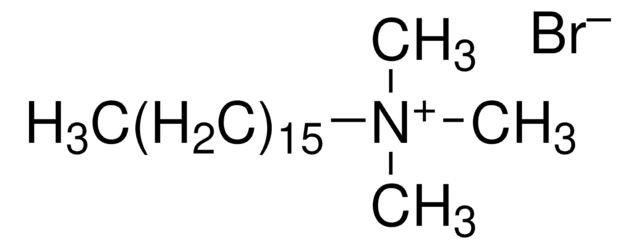Kluczowe dokumenty
360597
2,2,4-Trimethylpentane
ACS reagent, ≥99.0%
Synonim(y):
Isooctane
About This Item
Polecane produkty
klasa czystości
ACS reagent
Poziom jakości
gęstość pary
3.9 (vs air)
ciśnienie pary
41 mmHg ( 21 °C)
Próba
≥99.0%
Formularz
liquid
temp. samozapłonu
745 °F
granice wybuchowości
6 %
dilution
(for analytical testing)
zanieczyszczenia
≤0.0003 meq/g Water-soluble titr. acid
≤0.005% S compounds
pozostałość po odparowaniu
≤0.001%
kolor
APHA: ≤10
współczynnik refrakcji
n20/D 1.391 (lit.)
bp
98-99 °C (lit.)
mp
−107 °C (lit.)
rozpuszczalność
water: insoluble
gęstość
0.692 g/mL at 25 °C (lit.)
ciąg SMILES
CC(C)CC(C)(C)C
InChI
1S/C8H18/c1-7(2)6-8(3,4)5/h7H,6H2,1-5H3
Klucz InChI
NHTMVDHEPJAVLT-UHFFFAOYSA-N
Szukasz podobnych produktów? Odwiedź Przewodnik dotyczący porównywania produktów
Opis ogólny
Zastosowanie
- Synthesis of polyethyleneimine /silica hybrid nanoparticles.
- Amino acid quantification process.
- To dissolve di(2-ethylhexyl) phosphoric acid(DEHPA) to form a solution that is used in the extraction and back extraction of methylene blue.
Hasło ostrzegawcze
Danger
Zwroty wskazujące rodzaj zagrożenia
Zwroty wskazujące środki ostrożności
Klasyfikacja zagrożeń
Aquatic Acute 1 - Aquatic Chronic 1 - Asp. Tox. 1 - Flam. Liq. 2 - Skin Irrit. 2 - STOT SE 3
Organy docelowe
Central nervous system
Kod klasy składowania
3 - Flammable liquids
Klasa zagrożenia wodnego (WGK)
WGK 2
Temperatura zapłonu (°F)
10.4 °F - closed cup
Temperatura zapłonu (°C)
-12 °C - closed cup
Wybierz jedną z najnowszych wersji:
Masz już ten produkt?
Dokumenty związane z niedawno zakupionymi produktami zostały zamieszczone w Bibliotece dokumentów.
Nasz zespół naukowców ma doświadczenie we wszystkich obszarach badań, w tym w naukach przyrodniczych, materiałoznawstwie, syntezie chemicznej, chromatografii, analityce i wielu innych dziedzinach.
Skontaktuj się z zespołem ds. pomocy technicznej






